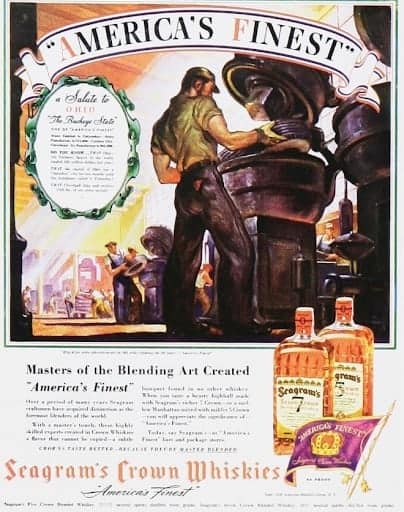While alcohol advertising regulations in the US aren’t nearly as strict as in many countries around the world, there are still significant barriers for alcohol advertisers—especially when it comes to digital marketing.
Just like any advertiser in the US, alcohol companies must abide by the Federal Trade Commissions (FTCs) Advertising and Marketing on the Internet Standards. That means ads must be truthful and without deception, but beyond that, the alcohol industry self-regulates its advertising in a unique way at a federal level.
If you’re looking to learn more about all the alcohol advertising restrictions for digital marketing, you’re in the right spot. From the history of alcohol advertising restrictions to current ones, we’ve put together everything you need to know in this article.
A brief history of alcohol restrictions in marketing
The US has a long history of alcohol advertising restrictions at a federal level. The first US ban on hard alcohol advertising in radio and TV was put into place in 1936, just three years after the end of prohibition.
 Despite this, beer and wine companies were allowed to continue advertising. At the time, liquor companies were looked down on far more by the public. This forced them to take out big ads in newspapers and magazines, instead of using the radio.
Despite this, beer and wine companies were allowed to continue advertising. At the time, liquor companies were looked down on far more by the public. This forced them to take out big ads in newspapers and magazines, instead of using the radio.
It wasn’t until 1996 that liquor companies began once again advertising on radio and TV, starting with Seagram’s Crown Royal. Despite backlash from some anti-alcohol advertising campaigns, liquor companies continued to advertise on TV and radio.
Since then, US courts have struck down—see Rubin v. Coors Brewing Co. (1995), Anheuser-Busch v. Schmoke (4th Cir. 1996)—regulations and bans on alcohol advertising at both a state and federal level numerous times, it seems alcohol advertising is here to stay.
In fact, since 1996, marketing and advertising spending at alcohol companies have seen incredible growth, topping $250 billion for the first time in 2018.
All of this spending is supposed to be regulated by the Tobacco Tax and Trade Bureau (TTB) under the Federal Alcohol Administration Act (FAA).
However, in practice, the TBB relies on the self-regulation of the industry based on guidelines from the Distilled Spirits Council of the United States (DISCUS), the Beer Institute (BI), and the Wine Institute (WI).
And courts continue to strike down state regulations due to first amendment arguments. For example, the Ninth Circuit court recently shot down Missouri’s anti-alcohol advertising law as well as California’s tied-house restrictions.
This leaves only weak federal regulations and independent company restrictions in place.
Current restrictions on alcohol marketing
Current federal regulations from the TTB for alcohol ads include requirements of what is to be included in advertisements and where they can be placed, among others. The regulations are interestingly dependent on the type of alcohol is being advertised, with wine, malt beverages, and distilled spirits, each having its own set of regulations.
All of these regulations’ effectiveness is recorded in reports put out by the FTC. The last one came out back in 2014.
According to the 2014 reports, over 90% of alcohol companies complied with the industry regulation.
Still, federal regulations lack enforcement powers, which puts alcohol companies in a unique self-regulating situation.
Social media alcohol advertising restrictions
Beyond state and federal restrictions, social media companies also place regulations on alcohol advertisers.
Although, for the most part, social media advertisers have taken the stance that as long as alcohol advertisers aren’t targeting children, they can advertise on their platforms, some social media platforms have banned alcohol ads altogether, like TikTok.
On the other hand, Facebook’s alcohol advertising policy does allow ads. This is similar to Twitter, Snapchat, and YouTube’s policies. However, the policies prohibit alcohol ads that are directed towards minors, and advertisements that imply drinking can be beneficial in social or sexual situations, among many other rules about ad placement. Still, there are social media marketing ideas for your beverage products that comply with regulations.
Google’s Alcohol Advertising Restrictions
Google’s alcohol advertising policy is meant to prevent alcohol advertising in countries where it’s banned, as well as irresponsible alcohol advertising.
According to Google, irresponsible alcohol-related advertising includes regulations that prevent companies from targeting consumers under 21 years of age, implying there are health benefits from the consumption of alcohol, or including the consumption of alcohol alongside the operation of a vehicle of any kind.
Beyond that, Google also bans certain ad formats. Gmail ads, dynamic search ads, and several other ad formats aren’t available for alcohol advertisers.
Growing pressure on alcohol advertisers
There has always been pressure on alcohol advertisers from groups like the “Just Say No’ Campaign of the 90s and early 2000s to Mothers Against Drunk Driving (MADD) today.
However, in the past five years, the pressure has started to increase with social media platforms like TikTok banning alcohol advertising altogether and city governments getting involved as well.
The City of Los Angeles’ 2015 ban on alcohol advertising tactics like bus stop signs is just one of the many examples that show consumer taste may be changing for alcohol advertising.
The Wall Street Journal said in a recent article on alcohol regulation:
“While regulators from New York City to Ireland to Ethiopia have cracked down on outdoor and broadcast ads for beer, wine and spirits in the past year, only a handful have targeted online ads. That is despite studies showing online alcohol marketing is often seen by people below the legal drinking age, and those exposed are more likely to start drinking or to drink heavily.”
Studies from Cornell University about how exposure to TV alcohol ads is linked to drinking behavior, for example, are what the Journal refers to.
Alcohol companies may be able to market their products on TV for now. Still, they should be looking for alternatives, given the changing public sentiment and growing scientific consensus against alcohol ads.

Digital marketing alternatives to alcohol advertising
Even if the restrictions on advertising for alcohol companies aren’t very strict, competition is intense. And, not only that, despite a whopping 400% increase in alcohol advertising from 1975-2015, Americans are drinking less alcohol per capita.
If consumers’ distaste for alcohol ads and the ads’ ineffectiveness means paying for advertising isn’t bringing in the customers, what will?
Digital marketing tactics, like search engine optimization, social media, and email marketing, are a great place to start. They target the right audience and humanize alcohol companies in a way paid ads can’t. You can also create a beverage blog to promote your products. For more information on digital marketing alternatives, feel free to contact us.
Markitors is a digital marketing agency specializing in SEO. We help small businesses rank higher on Google to get more traffic to their websites and increase revenue. Explore what’s in our food and beverage SEO toolbox: audits and keyword research, digital PR, technical SEO, and local SEO.







